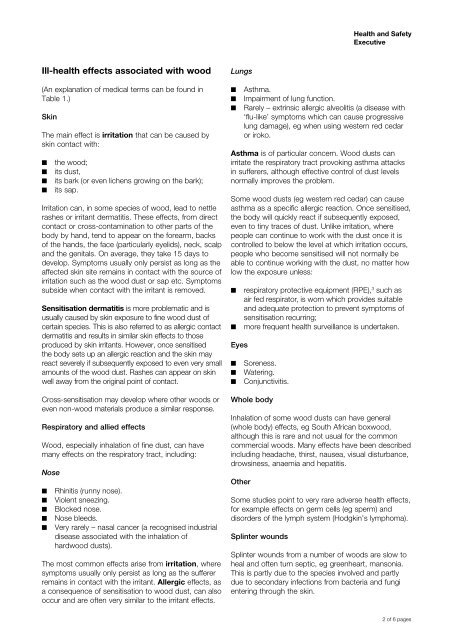Toxic woods WIS30 - HSE
Toxic woods WIS30 - HSE
Toxic woods WIS30 - HSE
You also want an ePaper? Increase the reach of your titles
YUMPU automatically turns print PDFs into web optimized ePapers that Google loves.
Health and Safety<br />
Executive<br />
Ill-health effects associated with wood<br />
(An explanation of medical terms can be found in<br />
Table 1.)<br />
Skin<br />
The main effect is irritation that can be caused by<br />
skin contact with:<br />
■■<br />
■■<br />
■■<br />
n<br />
the wood;<br />
its dust,<br />
its bark (or even lichens growing on the bark);<br />
its sap.<br />
Irritation can, in some species of wood, lead to nettle<br />
rashes or irritant dermatitis. These effects, from direct<br />
contact or cross-contamination to other parts of the<br />
body by hand, tend to appear on the forearm, backs<br />
of the hands, the face (particularly eyelids), neck, scalp<br />
and the genitals. On average, they take 15 days to<br />
develop. Symptoms usually only persist as long as the<br />
affected skin site remains in contact with the source of<br />
irritation such as the wood dust or sap etc. Symptoms<br />
subside when contact with the irritant is removed.<br />
Sensitisation dermatitis is more problematic and is<br />
usually caused by skin exposure to fine wood dust of<br />
certain species. This is also referred to as allergic contact<br />
dermatitis and results in similar skin effects to those<br />
produced by skin irritants. However, once sensitised<br />
the body sets up an allergic reaction and the skin may<br />
react severely if subsequently exposed to even very small<br />
amounts of the wood dust. Rashes can appear on skin<br />
well away from the original point of contact.<br />
Cross-sensitisation may develop where other <strong>woods</strong> or<br />
even non-wood materials produce a similar response.<br />
Respiratory and allied effects<br />
Wood, especially inhalation of fine dust, can have<br />
many effects on the respiratory tract, including:<br />
Nose<br />
■■ Rhinitis (runny nose).<br />
■■ Violent sneezing.<br />
■■ Blocked nose.<br />
■■ Nose bleeds.<br />
n Very rarely – nasal cancer (a recognised industrial<br />
disease associated with the inhalation of<br />
hardwood dusts).<br />
The most common effects arise from irritation, where<br />
symptoms usually only persist as long as the sufferer<br />
remains in contact with the irritant. Allergic effects, as<br />
a consequence of sensitisation to wood dust, can also<br />
occur and are often very similar to the irritant effects.<br />
Lungs<br />
■■ Asthma.<br />
■■ Impairment of lung function.<br />
n Rarely – extrinsic allergic alveolitis (a disease with<br />
‘flu-like’ symptoms which can cause progressive<br />
lung damage), eg when using western red cedar<br />
or iroko.<br />
Asthma is of particular concern. Wood dusts can<br />
irritate the respiratory tract provoking asthma attacks<br />
in sufferers, although effective control of dust levels<br />
normally improves the problem.<br />
Some wood dusts (eg western red cedar) can cause<br />
asthma as a specific allergic reaction. Once sensitised,<br />
the body will quickly react if subsequently exposed,<br />
even to tiny traces of dust. Unlike irritation, where<br />
people can continue to work with the dust once it is<br />
controlled to below the level at which irritation occurs,<br />
people who become sensitised will not normally be<br />
able to continue working with the dust, no matter how<br />
low the exposure unless:<br />
3<br />
■■<br />
respiratory protective equipment (RPE), such as<br />
air fed respirator, is worn which provides suitable<br />
and adequate protection to prevent symptoms of<br />
sensitisation recurring;<br />
■■ more frequent health surveillance is undertaken.<br />
Eyes<br />
■■<br />
■■<br />
■■<br />
Soreness.<br />
Watering.<br />
Conjunctivitis.<br />
Whole body<br />
Inhalation of some wood dusts can have general<br />
(whole body) effects, eg South African boxwood,<br />
although this is rare and not usual for the common<br />
commercial <strong>woods</strong>. Many effects have been described<br />
including headache, thirst, nausea, visual disturbance,<br />
drowsiness, anaemia and hepatitis.<br />
Other<br />
Some studies point to very rare adverse health effects,<br />
for example effects on germ cells (eg sperm) and<br />
disorders of the lymph system (Hodgkin’s lymphoma).<br />
Splinter wounds<br />
Splinter wounds from a number of <strong>woods</strong> are slow to<br />
heal and often turn septic, eg greenheart, mansonia.<br />
This is partly due to the species involved and partly<br />
due to secondary infections from bacteria and fungi<br />
entering through the skin.<br />
2 of 6 pages

















